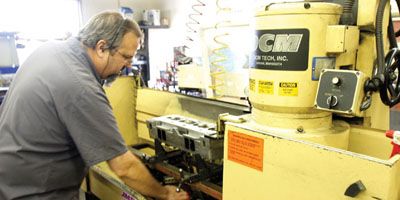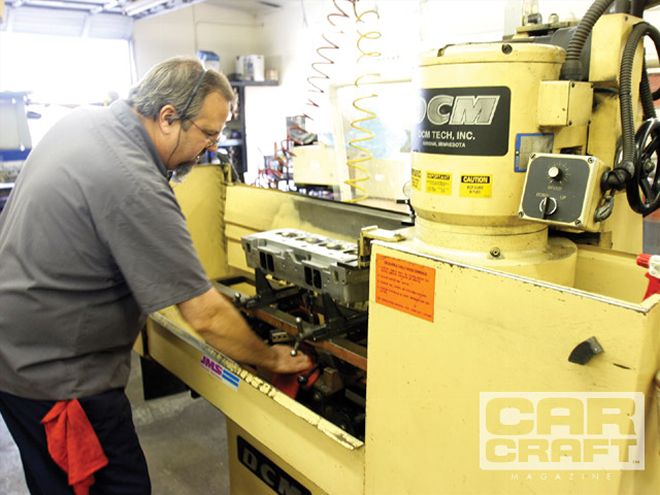

"Heads are everything." That's what Air Flow Research's Tony Mamo said to us in a recent phone conversation. "What to do with the heads is the most critical decision to make in any engine build."
To see firsthand what goes into building a set of heads, we spent an afternoon with JMS' Pete Hillemeyer, a guy who's been building cylinder heads for more than 20 years. We also sought the counsel of the School of Automotive Machinists' Judson Massingill and Advanced Induction's Phillip Odom, in addition to the advice Mamo gave us. We wanted their take on where to spend your money when assembling a pair of heads.
The baseline for any cylinder head buildup begins with a thorough reconditioning of the heads, and that typically involves disassembly and cleaning, surfacing (if needed), regrinding the valve angles and seats, knurling or replacing the guides, installing new valve seals, and checking the springs. We'll show you what can be done during this process to tune up the heads to flow more air.
Guides And Seals
The first step to performance cylinder head work involves checking the valveguides for wear. Worn guides and seals cause oil consumption by allowing oil to leak past the valve stem into the combustion chamber. A telltale sign of worn seals and guides is a puff of blue smoke on a cold start-up or when they're really bad, a smoke screen when you pull away from a stop after idling for a while.
More detrimental than bad oil control, worn guides don't control the movement of the valve properly. Floppy, erratic movement makes it difficult for the valve to seat fully during each event cycle. If the valves don't seat properly, they won't seal the combustion chamber-and there goes your horsepower out the exhaust port.
Guides can be knurled if they are badly worn, but if they've been fixed more than twice, they should be replaced with press-in bronze inserts called false guides. Once the guides are in spec and properly located in the head, the valve seats can be cut in their proper locations. After the guides are repaired, always replace the valve seals.
Valve Jobs And Airflow
Mamo says the best thing you can do to a stock pair of heads is improve the low- and mid-lift airflow levels, and there are a couple of relatively inexpensive ways to do that. The first is to back-cut the valves. Most valves have a wide, 45-degree-face angle. By narrowing that angle with an appropriate back-cut, you increase low-lift flow because there is less material for the air to flow around and there is a smoother transition on the backside of the valve. Mamo says this adds 10 to 12 cfm of flow from the crank of the valve up to 0.300-inch lift. He says valves are generally back-cut at a 30-degree angle in the area between where the valve seats to the head and the valve stem.
The second flow improver is a three-angle valve job. Three-angle refers to three different cuts, 30, 45, and 60 degrees, machined into the seat in the cylinder head, not the valve. The three angles in the head are arranged from shallow to steep and form a funnel shape leading from the combustion chamber down into the runners. The middle angle, 45 degrees, must match the valve cut. That is where the valve seats or when it is closed. The shallow 30-degree cut is between it and the combustion chamber, and the 60-degree cut is between it and the bowl area of the runner.
Also, you should know the 30- and 60-degree numbers are generic figures that represent a range of possible angles your machinist prefers for your application. Massingill tells us small-block Chevys react well to 38-, 45-, and 58-degree angles, while Gen III Chevys and most Fords like 38-, 45-, and 64-degree valve jobs. Each head is different, and the valve job angles and widths are some of engine builders' most closely guarded secrets.
Most aftermarket performance valves are made from stainless steel, but Massingill says calling them stainless is the same as calling the stuff on the ground dirt. There is a wide variety of stainless steel alloys used to make valves. The best alloys, like Inconel, are stronger and can take more heat without deforming. They are priced accordingly. Most manufacturers have different levels of valves, ranging from budget to race, and the prices can be as low as $25.00 or more than $200.00 for a set of eight. Massingill recommends buying the best valves you can afford.
Milling
If you've got heads with relatively large combustion chambers, you can have them machined in an attempt to raise the compression ratio. Discuss this option thoroughly with your builder, though. You don't want to take off so much material that you'll have to machine the intake manifold mounting flange or need to buy nonstandard pushrods to get everything to fit. Massingill tells us milling the heads by as little as 0.030 inch can result in a performance gain.
Studs And Rocker Arms
Stock small-block Chevys have 7/16-inch pressed-in studs, and these are often replaced with 3/8-inch screw-in studs. Of course, you'll have to install new rocker arms to match the bigger studs to prevent them from being pulled out by the rocker arm. This is not a bad thing, however, because stock, stamped-steel rocker arms flex, and tests have shown they often do not deliver the ratio they are supposed to. If a stock rocker arm ratio is 1.5:1, it will open the valve 1.5 times the amount of lift provided by the cam lobe. In reality, some stock rocker arms have been shown to only deliver a ratio of around 1.44:1.
Comp Cams and Summit Racing sell a set of stamped rockers with roller tips for less than $160.00. They are much stronger than stock, and according to our sources are as strong as the flashy aluminum pieces and lack only the roller bearing fulcrums. Some builders vary the ratios from intake to exhaust, too. Adding a bigger-ratio rocker to the exhaust valves can often help out heads with weak exhaust ports by opening the valves a little faster.
Springs
Spring choice is a trial-and-error process and is affected by a number of factors, including the weight of the valves, retainers, and keepers; the type of lifters you're using; and the shape of the cam lobe and how quickly it opens and closes the valves. Massingill says it's better to run spring pressure that's a little too high than pressures that are too low. Though too much spring pressure can flatten a cam lobe, too little pressure robs all your high-rpm power. The valves will float because the springs aren't strong enough to make them close fully at high engine speeds. An experienced engine builder will be able to recommend springs that are good for your combination. However, if you have access to a dyno and feel like experimenting, Massingill says to keep adding spring pressure until valve float goes away.
Porting
It's true that a lot of extra airflow can be realized by porting the runners, but it's just as easy to ruin a good set of heads with a bad porting job. To port a cylinder head means changing the size, shape, and finish of the runners. It's a process done by hand or a CNC machine. Reshaping the runners' path, especially in the transition area where the runner necks down to the valve opening, increases the velocity of the air traveling into or out of the combustion chamber, making your cylinder heads breathe more efficiently.
Porting the runners is a job best left to your engine builder, but there are a few things a guy can do at home. An easy procedure is called gasket-matching. It involves grinding away extra material at the port opening so it matches the exact shape of its gasket.
If your budget permits it, you could have your heads fully ported. If not, look into what's referred to as pocket-porting to clean up the area in the bowls and the transition area between the runners and the valve seats. "It blends the valve job into the bowls and you can gain 20 to 30 hp if this is done properly on stock heads," Mamo tells us. It's more affordable, too. Pocket porting may run you about $300.00, compared with a $1,000.00 port job.
Ambitious sorts can take a stab at pocket-porting their heads in the interest of saving money. Massingill tells us he used to always pocket-port his own heads. But this brings us to the inevitable conclusion: Is all this work worth it? How much money will you have invested in hopping-up your stock castings and how does that figure compare with what it would cost to buy a set of aftermarket heads?
"The problem is that you're working with old technology with stock castings," Mamo says.
"That is the age-old question," Massingill quips. "The cost of new heads is so affordable and the technology is so good that it is almost a better investment to spend your money on aftermarket heads." He admits he often counsels his students at the School of Automotive Machinists to skimp on building the short-block if money is that tight and spend the extra money on cylinder heads as long as the reliability of the short-block is not compromised.
Our guys all agree that stock heads should at least get a good valve job, back-cut valves, and have the bowls pocket-ported. The bill for all that work can quickly run up more than $600.00, and that's not much of a screaming deal when you figure you can buy a new pair of aluminum Patriot cylinder heads for small-block Fords and Chevys for less than $1,000.00. Most new aftermarket cylinder heads are probably better out of the box than your stock heads, and many are better than OE heads could ever be, no matter how much money and work you throw at them. The Patriot Chevy heads offer similar performance to a factory Vortec head, one of the best production heads GM has made. And according to Mamo and Massingill, production Ford heads flow so badly, you're almost better off buying aftermarket heads from the start. Do your research when deciding where to spend your money.